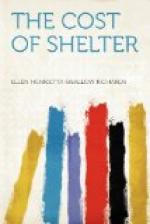The environment is, more largely than we think, the house and the manner of life it forces upon us. Therefore the first point of attack is the shelter under which the family life of the newly married pair establishes itself. If it is too large for their income, it leads to extravagance and debt before the first two years have passed; if it is too small, it cramps the generous and hospitable impulses. If unsuited to this need, it irritates and deforms character, as a plaster cast compresses a limb encased in it.
Imagine the young people beginning life in the average city flat, at a rent of twenty to thirty dollars a month, with its shams, its makeshifts, its depressing, unsanitary, morally unsafe quarters for the maid, its friction with janitor and landlord—the whole sordid round necessitated by the mere manner of building, and by that only.
A few strong souls flee to the country. Counting the cost and finding that all the earnings go to mere living, they decide to get that living in company with nature under free skies—their own employers. Such may live in Altruria with the happy zest of the authors of that charming sketch.
It is not given to many of earth’s children to be so well mated and so heavenly-wise. The young man has been brought up to consider the house the young wife’s prerogative, and she—well, she has been trained to believe that housewifely wisdom will come to her as unsought as measles.
Two thirds the friction in the early years of married life is caused by the house and its defects, resulting in dissatisfaction, disenchantment, and the flight to a hotel or non-housekeeping apartment.
If some of the problems to be faced and the difficulties in solving them could be presented to the young people to be studied and discussed before the actual encounter came, they would be more prepared.
In discussing this part of the subject, as in the consideration of the Cost of Living in general and the Cost of Food, we shall deal in particular with incomes of from $1000 to $5000 a year for families of five, recognizing that under present-day conditions the annual sum of $1500 to $3000 means the greatest struggle between desires and power of gratifying them.
On the surface it appears that the things which go to make up delicate cleanly living cost more and more each year, with no limit in sight. It is not only the poet who moves from one boarding-house to another; the young clerk and struggling business man go into smaller and smaller quarters until the traditional limit of room to swing a cat is reached.
The constantly diminishing space occupied by a family seems to prove that the 40% increase in the cost of living within a few years is not caused by an advance in the necessary cost of food; it is certainly not due to the increased cost of necessary clothes. It is more than probable that the increasing cost of shelter and all that it implies—increased water-supply, service, repairs, etc.—is the main factor in the undoubtedly increased expense. This will be considered in some detail in Chapter VIII.




